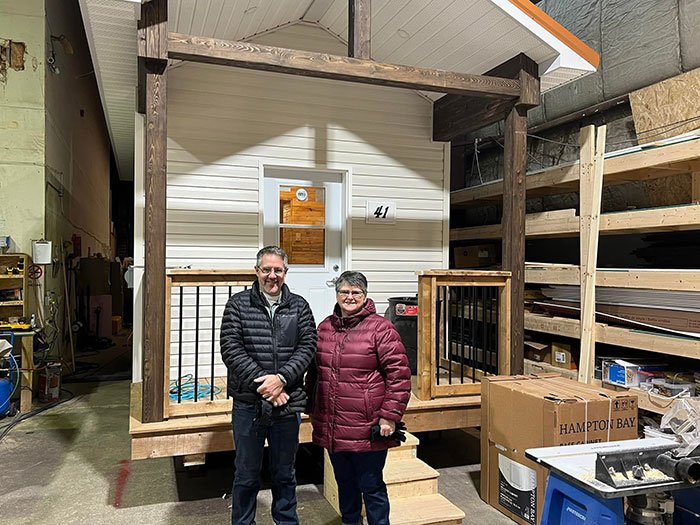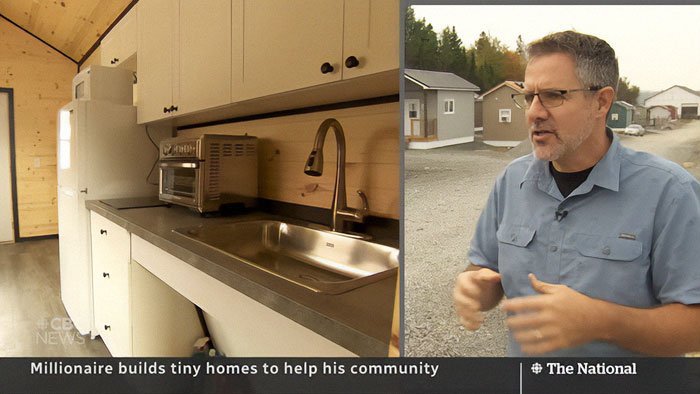Homelessness is a problem that many cities face around the world. Even though governments and organizations are trying to fix it, it’s still a big issue. One Canadian millionaire decided to make a difference in his own town with his money. Here’s his story.
In Fredericton, New Brunswick, Marcel LeBrun, a millionaire entrepreneur, took action to help homeless people in his community. Marcel, who made a lot of money from his successful social media monitoring company, decided to invest $4 million of his own money to build 99 tiny homes for those in need. He didn’t just stop at providing homes; he also created job opportunities with his unique approach. This project is called 12 Neighbours.
After selling his company and gaining a lot of wealth, Marcel wanted to use his money for good. Seeing the homelessness issue in Fredericton, he came up with the idea of a tiny home community to give homeless people a new start. He named his project 12 Neighbours and aimed to build a gated community with 99 homes and an enterprise center. This community offers both housing and job opportunities, giving homeless people a chance to rebuild their lives.

Homelessness is a big issue in New Brunswick, with about 1,600 people experiencing it in a single day last year. In bigger cities like San Francisco, Los Angeles, and New York in the United States, the number of homeless people is much higher. Marcel LeBrun saw a chance to make a difference and decided to help those struggling with homelessness.
Marcel’s project, 12 Neighbours, is not just about building tiny homes. He wants to create a supportive community for people. The tiny homes he’s building are more than just places to stay. They are fully-furnished with kitchens, living areas, bedrooms, and full bathrooms. They even have solar panels on the roofs. Marcel sees himself as a community builder, aiming to provide a better life for those in need.

To make his vision a reality, Marcel LeBrun set up a factory where skilled volunteers help build the tiny homes. Using modern techniques, the factory can produce one tiny home every four business days. Once a home is built, it is carefully placed on concrete blocks to form the foundation of the community.
Marcel believes that owning a home is important because it gives people a sense of responsibility and stability. By allowing people who have experienced homelessness to own their own homes, the 12 Neighbours project aims to empower them and create a supportive community.

Besides providing homes, Marcel LeBrun’s project also focuses on creating job opportunities for the residents. The 12 Neighbours community includes an enterprise center with a coffee bar and a silk printing business, both run by the residents. This helps generate income and encourages residents to interact with the wider community.
Like any big project, 12 Neighbours has faced criticism. Some people think it’s better to reintegrate homeless individuals directly into society rather than keeping them together in one place. However, Marcel understands these concerns and has taken steps to ensure the community is safe and supportive.
Marcel explained, “Building a few homes is just as complicated as building many, and we wanted to make a real impact on homelessness in Fredericton. If we want to make a meaningful difference, we need to build houses. If I take someone who’s been living outside and put them in a luxury apartment, they might not succeed because it’s not their community or environment.”

Marcel LeBrun knows how important safety is, so he has included top security features in the 12 Neighbours community. There are gated entrances and advanced surveillance systems to ensure residents feel safe and protected.
LeBrun mentioned that some residents face challenges when they first move in. He explained, “When someone moves into a house, they might have others trying to take advantage of them. They need to learn what it means to manage their own space and decide who they let in and out.”
One of the main goals of 12 Neighbours is to build a strong sense of community both inside and outside its gates. LeBrun wants to create a place where residents and the people of Fredericton can come together. The community has a coffee bar and a personalized printing business to encourage interaction and understanding.
LeBrun told CBC, “I see myself as a community builder. We’re not just building a small community; we’re helping to make our city better.”
Marcel LeBrun’s project to build 99 tiny homes in Fredericton, New Brunswick, is a great example of using personal success to help others. Through 12 Neighbours, he has not only provided homes for those in need but also created job opportunities and a supportive community. His efforts have given hope to many and inspired others to make a difference.
Decoding SPAM: Exploring the Ingredients Behind the Iconic Canned Meat
Ever wondered what goes into the iconic canned meat known as SPAM? You’re not alone! For decades, SPAM has found its way into households worldwide, thanks to its distinctive taste and versatility. Let’s take a closer look at this famous product and discover what makes it so unique.
Introduced by Hormel Foods in 1937, SPAM quickly became a household staple. Surprisingly, the true origin of the name “SPAM” is still debated. Some believe it stands for “Shoulder of Pork And Ham,” while others suggest it might mean “Specially Processed American Meat.” The mystery surrounding its name only adds to the allure of this classic product.

SPAM comes in a wide range of flavors to suit different tastes. While the original SPAM remains popular, you can now find variations like Hickory Smoke, Hot & Spicy, and even SPAM with Cheese. The basic recipe includes just six ingredients: pork with ham, salt, water, potato starch, sugar, and sodium nitrite.
A key ingredient, sodium nitrite, often raises questions. This compound serves as a preservative in processed meats, helping prevent bacterial growth and spoilage to keep products like SPAM fresh and safe. Though sodium nitrite is essential for shelf stability, some people may choose to limit their intake of preservatives or sodium.
Interestingly, the name “SPAM” was suggested by actor Ken Daigneau, who was the brother of a Hormel Foods executive. During a company contest, Ken coined the name and won a prize of $100—a substantial amount in the 1930s. Little did he know that his creation would become an enduring part of pop culture.

Beyond being just a canned meat, SPAM has evolved into a cultural icon, inspiring countless recipes, songs, and even stage productions. Its versatility allows it to be prepared in multiple ways, from frying and baking to grilling or eating it straight from the can. SPAM works its way into all kinds of dishes, from breakfast to sandwiches, pizza, and even sushi.
Since its debut in Austin, Minnesota, SPAM has grown into a beloved culinary fixture around the world. While the origins of its name remain part of its charm, the simple blend of pork, ham, and seasonings makes SPAM a unique addition to many meals.
Whether you’re a fan or curious to try it, SPAM continues to delight taste buds and inspire creativity. So, next time you spot that unmistakable blue and yellow can, why not give SPAM a try? You might just find a new favorite!
Feel free to SHARE this article with your friends and family!



Leave a Reply